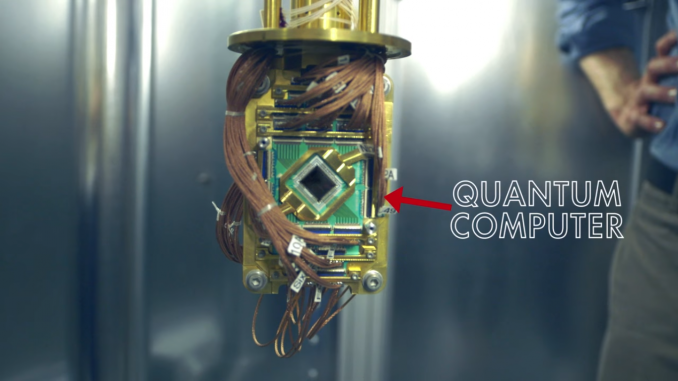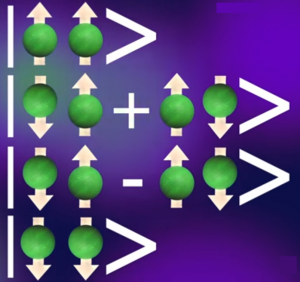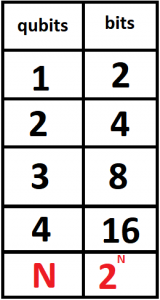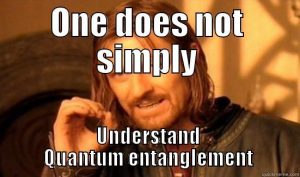

A classical computer performs operations using classical bits, which can be either zero or one. Now, in contrast, a quantum computer uses quantum bits or qubits. And they can be both zero and one at the same time. And it is this that gives a quantum computer its superior computing power. There are a number of physical objects that can be used as a qubit. A single photon, a nucleus or an electron. Some researchers using the outermost electron in phosphorous as a qubit. But how does that work? Well, all electrons have magnetic fields, so they are basically like tiny bar magnets. And this property is called spin. If you place them in a magnetic field they will align
with that field, just like a compass needle lines up with the magnetic field of the earth. Now, this is the lowest energy state, so you could call it the zero state or we call it for the electron, spin down. Now you can put it in a one state, or spin up, but that takes some energy. If you took out the glass from your compass you could turn the needle the other way, but you would have to apply some force to it. You have to push it to flip to the other side. And that is the highest energy state. In principle, if you were so delicate to really put it exactly against the magnetic field, it would stay there. Now so far this is basically just like a classical bit.

It has got two states, spin up and spin down, which are like the classical one and zero. But the funny thing about quantum objects is that they can be in both states at once. When you measure the spin it will be either up or down.
But before you measure it, the electron can exist in what is called a quantum superposition, where these coefficients indicate the relative probability of finding the electron in one state or the other. It is hard to imagine how this enables this incredible computing power of quantum computers without considering two interacting quantum bits. Now there are four possible states of these two electrons.


You could think that, well, that is just like two bits of a classical computer. If you have two bits you can write 00; 01; 10; 11. There is four numbers. But these are still just two bits of information. Right? Determine which one of the four numbers you have in your computer code is the value of the first bit and the value of the second bit.
Quantum mechanics allows to make superposition of each one of these four states. So determine the state of this two spin system, I need to give you four numbers, four coefficients, whereas, in the classical example of the two bits, I only need to give you two bits.
So this is how you understand why two qubits actually contain four bits of information. I need to give you four numbers to tell you the state of this system, whereas here I only need two. Now if we make three spins, we would have eight different states and it could give you eight different numbers to define the state of those three spins, whereas classical it is just three bits. If you keep going, what you find is that the amount of equivalent classical information contained by N qubits is two to the power N classical bits.
And, of course, the power of exponentials tells you that once you have, let’s say, 300 of those qubits in what we call the folient angle state, so you must be able to create these really crazy states where there is a superposition of all three angles being one way and another way and another way and so on, then you have like two to the 300 classical bits, which is as many particles as there are in the universe. But there is a catch, although the qubits can exist in any combination of states, when they are measured they must fall into one of the basis states. And all the other information about the state before the measurement is lost. So you don’t want generally to have as the final result of your quantum computation something that is a very complicated super positional state, because our cannot measure a superposition. You can only measure one of these basis states. Like down, down, up, up. Yeah. So what you want is to design the logical operations that you need to get to the final computational result in such a way that the final result is something you are able to measure, just a unique state.
I guess it is to some degree the reason why quantum computers are not a replacement of classical computers. They are not universally faster. They are only faster for special types of calculations where you can use the fact that you have all these quantum super positions available to you at the same time, to do some kind of computational parallelism. If you just want to watch a video in high definition or browse the internet or write some documenting work, they are not going to give you any particular improvement if you need to use a classical algorithm to get the result. So you should not think of a quantum computer as something where every operation is faster. In fact, every operation is probably going to be slower than in the computer you have at your desk. But it is a computer where the number of operations required to arrive at the result is exponentially small. So the improvement is not in the speed of the individual operation. It is in the total number of operations you need to arrive at the result. But that is only the case in particular types of calculations, particular algorithms. It is not universally, which is why it is not a replacement of a classical computer.
